Photographs: Rediff Archives Masoom Gupte in Mumbai
When myriad portals are selling everything from personal items like apparel and shoes to financial products like insurance and mutual funds cropped up over the past couple of years, many said e-commerce was coming of age in India.
But now, with the Tata Group owned electronic goods retail chain Croma foraying into online retail, one is tempted to say e-commerce has finally arrived.
. . .
How Tata Croma plans to make it big
Image: Customers use the escalators at a shopping centre.Photographs: Daniel Munoz/Reuters
Croma launched its online arm, Croma Retail, last month, extending its reach from the 14 cities the chain is currently present in through brick and mortar stores to a virtual presence in 319 cities, covering around 6,000 pin codes.
More pin codes will be added every week going further.
"We've noticed our consumers are not short on resources. But, while in major metros they are short on time, in the smaller cities they have limited access to the latest gadgets and electronic items," says Ajit Joshi, MD and CEO, Infiniti Retail, the wholly owned subsidiary of Tata Sons, which runs the multi-brand electronics store chain Croma, explaining the latest initiative.
The photograph is used for representative purpose only
. . .
How Tata Croma plans to make it big
Joshi's reasons are in place, but he also has numbers on his side to support this move.
According to a November 2011 report on the digital commerce industry by financial services firm Avendus Capital, the Indian e-commerce market is estimated at Rs 28,500 crore (Rs 285 billion).
Online travel transactions constitute almost 87 per cent of this, way higher than that in any other country under consideration -- like the US, where online travel transactions stand at 37 per cent of the overall pie.
The rest of the pie in India (13 per cent) is contributed by e-tailing, a Rs 3,600 crore (Rs 36 billion) industry.
Avendus predicts this market will be 10 times its current size in just four years.
. . .
How Tata Croma plans to make it big
They estimate it to grow to about Rs 53,000 crore (Rs 530 billion) by 2015, achieving an overall penetration of 1.4 per cent.
This is still very small compared to China where it is already at 4 per cent.
Based on these estimates and Joshi's rationale, an online presence would be the fastest way to scale up operations for a player like Croma and increase its reach manifold. But first they must spot their customers.
Changing customer profile
Anand Ramanathan, associate director at KPMG, doesn't think the brick and mortar stores and online model will jostle for the same set of customers.
"The touch and feel factor continues to dominate the purchasing habits especially for large appliances and are hence restricted to store buying," he says.
. . .
How Tata Croma plans to make it big
"It may not be as important for smaller gadgets or standard accessories like cartridges, which may be easily bought over the internet. Online medium also helps greatly with pre-buying decision making."
Also, given that Croma's physical footprint is still very small, the possibility of an overlap among consumers is on the lower side.
However, if the orders received by Croma during the first seven days of the website going live are any indication, it is safe to assume that the well-documented predilection of the Indian consumer with regard to the 'touch and feel' factor is changing.
Croma has received orders for air conditioners, coolers and refrigerators in addition to laptops, iPads and mobile phones from across the cities it has a digital presence.
. . .
How Tata Croma plans to make it big
Another myth to be busted here: the average sale price for tier 2/3 cities is almost double that of the top metros.
It stands around Rs 10,000 versus the Rs 5,000 ASP for top metros.
In fact, smaller cities seem to have a voracious appetite for high-end electronic gadgets. "The mindset is changing and there is a cultural shift.
"What helps is, these are cash rich customers, for whom there is also something of a snob value in owning the latest and expensive gadgets," says an executive associated with Croma Retail.
There is no denying the online story sounds promising.
But, one cannot ignore the challenges in building a successful business model in the space.
. . .
How Tata Croma plans to make it big
Image: Ratan Tata.Photographs: Dan Kitwood/Getty Images
The challenges will be unique -- among them are things like ensuring on-time deliveries as well as managing the consumer expectations even from the delivery crew.
The distribution model thus becomes key in an online business.
Here the company must bridge the last mile -- reach out to the consumer, rather than vice-versa.
Managing distribution
A common practice in e-tailing is to outsource the management of forward logistics, while the company would focus on managing the back-end operations.
Only few players, like Flipkart, have moved away from this, choosing to manage its logistics end-to-end.
. . .
How Tata Croma plans to make it big
Photographs: Reuters
Most others rely on tie-ups with courier companies for the last mile deliveries.
Croma seems in no rush to defy the established wisdom.
The company has tied up with courier companies FedEx and Blue Dart and fellow Tata Group logistics company Diesl.
While Joshi doesn't divulge details about the particular regions to be catered to by each of these companies or any other split of services, he says that one of the partners would handle smaller appliances and laptops.
The other two will handle deliveries of large appliances.
Croma is also in talks with India Post for a delivery tie-up. "No player can compete with India Post when it comes to reach.
. . .
How Tata Croma plans to make it big
Image: Indian currency notes are stapled to form a garland at a shop in Jammu.Photographs: Mukesh Gupta/Reuters
"The network is vast and spans even the remotest hinterlands," says Joshi.
A fact endorsed by industry experts who point out that courier companies have an approximate reach of around 2,000 pin codes currently.
The number is less than half of the targeted pin codes.
Joshi adds, "We are now in final stages of talks and verifying its (India Post's) capabilities for delivering large appliances as well."
With e-commerce, there is always a chance of returns and hence the need for a strong reverse logistics model as well.
While Croma doesn't anticipate too many returns, it has made arrangements with the same players for managing the same.
The costs per delivery as per the Avendus Capital report could range from Rs 35-75 and for reverse logistics it can vary from Rs 40-55.
. . .
How Tata Croma plans to make it big
Photographs: Reuters
This cost will be absorbed by Croma.
Experts endorse this approach of outsourcing the forward as well as reverse logistics.
"E-tailing isn't developed enough or hasn't received the required scale for businesses to invest considerably in supply chains.
"As things stand now, it is still just a medium for businesses to test waters. And to do so, tie-ups with courier companies are a quick and not-so-expensive-to-manage option," says Pinakiranjan Mishra, partner and national leader, retail and consumer products, Ernst & Young.
Currently, Croma has seven distribution centres across India that cater to its physical stores, managed by Australian retail major Woolworths: Bhiwandi (caters to the stores in Maharashtra), Gandhinagar (Gujarat), Hyderabad (Andhra Pradesh), Bengaluru (Karnataka), Chennai (Tamil Nadu), Delhi (Haryana, Delhi and Uttar Pradesh) and the recently opened centre at Jalandhar to supply to Punjab.
. . .
How Tata Croma plans to make it big
Image: Shoppers use escalators inside a shopping mall.Photographs: Vivek Prakash/Reuters
Till now, the chain followed a largely hub and spoke model, with a DC catering to a certain catchment area.
It will continue to do so for its physical stores.
The chain plans to add another 83,000 square feet real estate in the coming year, taking its store count from 72 to 86.
The aim will be to go deeper within the cities that Croma is already present in and extend reach through the online model, which will be serviced by the same DCs.
"As a retailer, margins do not grow overnight, so we need to work on controlling costs. For instance, if we advertise, say through print, it's easier to ensure effectiveness of such communication if you have multiple stores in the same city. The spread can become too thin if we look at a multiple-city model and the realisation of that rupee can become a problem," explains Joshi.
. . .
How Tata Croma plans to make it big
Like most businesses, the chain operates a one-distribution-centre-per-state model because of varying central sales taxes.
However, once the country moves to the Goods and Services tax regime, Joshi is hopeful of shifting to a four to five distribution centre model that will cover regions rather than individual states.
Until then, the current model shall serve.
The chain has no immediate plans for new DCs specifically to take its online ambitions further.
However, the company has opened a dialogue with its suppliers, that is the brands, like Sony, Samsung, LG etc, possibly to ensure that its maximum-seven-day delivery time promise is fulfilled.
"These partners (brands) have their own networks and depots in place in large numbers around the country. We are exploring the possibility of leveraging this," says Joshi.
. . .
How Tata Croma plans to make it big
"The challenge here is to establish a strong communication link between these centres or depots and the chain's order management system.
"The solution though will come through technology. And the process will be simplified once Croma figures out how best to communicate electronically with all its partners.
The Croma experience
The company has stated categorically that its online foray will not translate into any kind of 'discounted buying' opportunities for the consumer.
It will focus on product bundling and services instead to attract consumers.
Examples of bundling include 'buy laptop and get printer free' or 'buy fridge and get food processor free'.
According to the company this is very popular with consumers.
. . .
How Tata Croma plans to make it big
Image: A woman carries shopping bags.Photographs: Vincent Kessler/Reuters
For instance, the chain offers a Rs 100,000- wedding pack that include most of the electronics products necessary to set up a new home.
These are a hit with information technology professionals who shift cities very often, according to Joshi.
With regard to service, Croma will now offer consumers a 'standby' option.
If your product purchased from one of its stores breaks down, the company will replace it with another on a temporary basis at no extra cost till your own product gets repaired.
The facility is available for a few product categories only, and is currently limited to customers in Mumbai, Delhi and Bengaluru who've made their purchases from the stores. It will soon be extended to the online customers within these cities.
By September the service will be rolled out to all Croma customers.
The photograph is used for representative purpose only
. . .
How Tata Croma plans to make it big
Photographs: Reuters
Croma, which started its operations 2006 and clocked a revenue Rs 1,970 crore (Rs 19.7 billion) last fiscal, says the online model has the potential to generate similar revenues within just two years.
The prerequisite being that the Indian government's ambitious 'internet in every village by 2014' plan is realised. Industry experts are cautious though.
Whether the Rs 2,000-crore (Rs 20-billion) revenue comes through or not in the next two years, Croma has made a start.
With almost no competition currently, it will also have the first mover advantage.
And if the rising purchasing power of the Indian middle class, that resides beyond the top cities is a reality, the journey promises to be exciting.

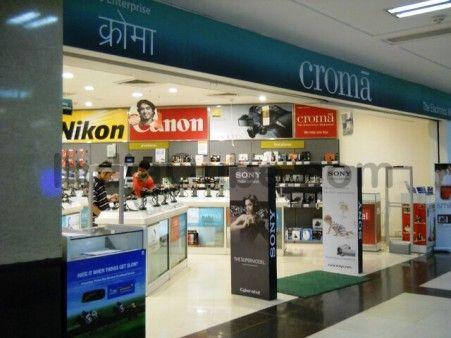

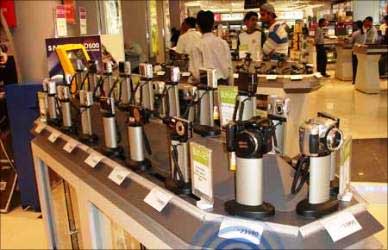
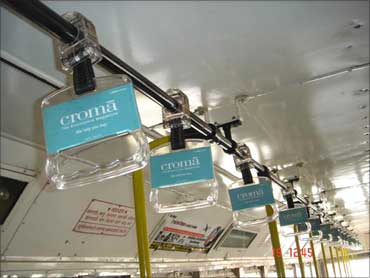
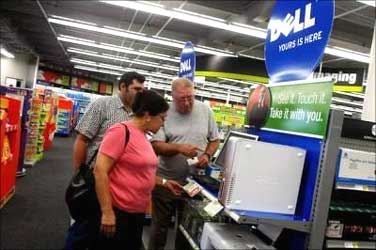
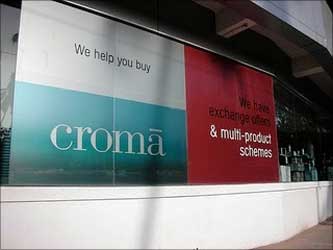
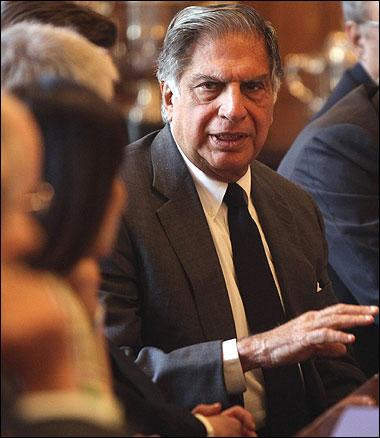
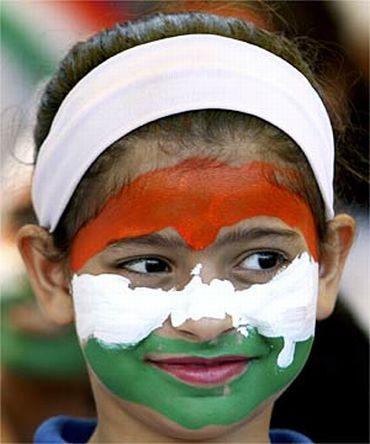








article